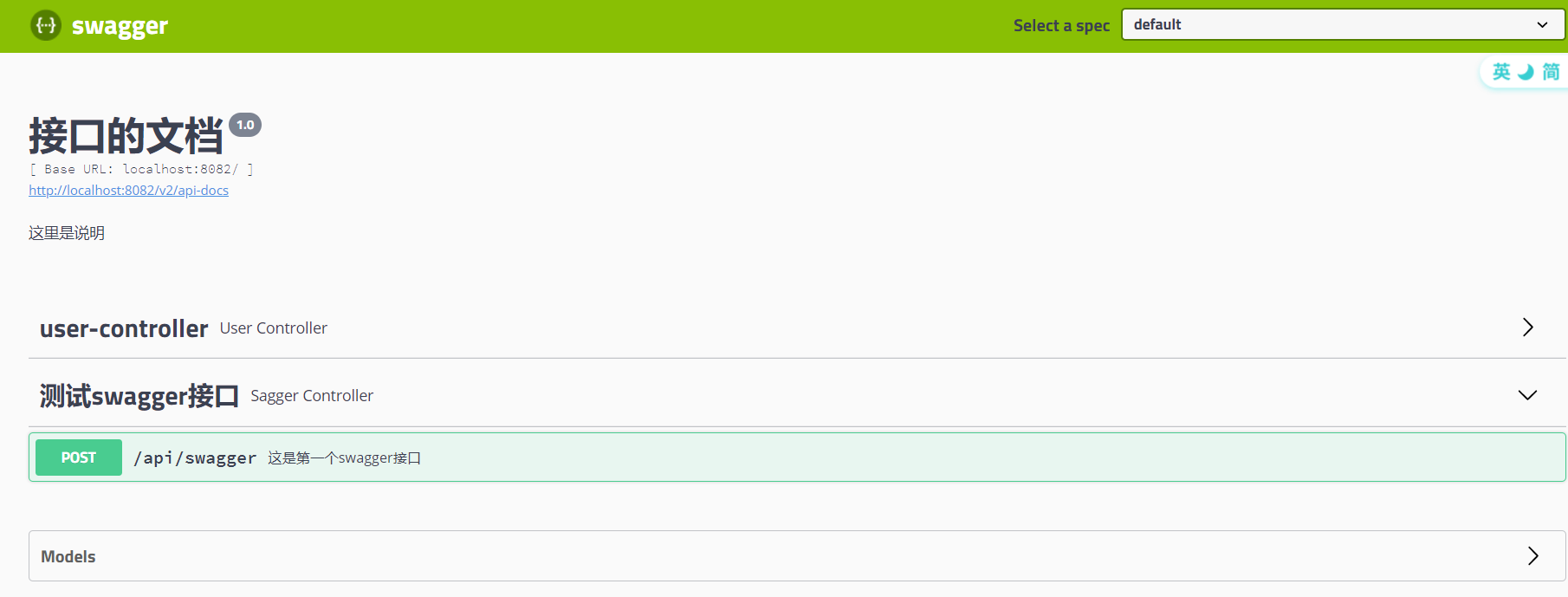Import dependency
<dependency>
<groupId>io.springfox</groupId>
<artifactId>springfox-swagger2</artifactId>
<version>2.9.2</version>
</dependency>
<dependency>
<groupId>io.springfox</groupId>
<artifactId>springfox-swagger-ui</artifactId>
<version>2.9.2</version>
</dependency>
configuration file
@Configuration
@EnableSwagger2
public class SwaggerConfig {
@Bean
public Docket createDocket() {
return new Docket(DocumentationType.SWAGGER_2)
.apiInfo(apiInfo())
.select()
.apis(RequestHandlerSelectors.basePackage("com.djy.demo.controller"))//Scan package
.paths(PathSelectors.any())
.build();
}
private ApiInfo apiInfo() {
return new ApiInfoBuilder().title("Interface documentation").description("Here is the description").version("1.0").build();
}
}
Code use
@Data
public class ApiUserVO {
@ApiModelProperty(value = "Primary key")
private String id;
@ApiModelProperty(value = "password")
private String username;
}
@RestController
@RequestMapping("/api")
@Api(tags = "test swagger Interface")
public class SaggerController {
@ApiOperation(value = "This is the first swagger Interface")
@PostMapping("/swagger")
public SwaggerVO testSwagger(@RequestBody SwaggerVO vo) {
return vo;
}
}
visit http://localhost:8080/swagger-ui.html

Common notes
- @Api() is used for class;
Indicates that this class is a resource of swagger - @ApiOperation() is used for the method;
Represents the operation of an http request - @ApiParam() is used for method, parameter and field description;
Indicates the metadata added to the parameter (description or required, etc.) - @ApiModel() for class
Represents a description of the class, which is used to receive parameters with entity classes - @ApiModelProperty() is used for methods and fields
Represents a description of the model property or a data operation change - @ApiIgnore() is used for classes, methods, and method parameters
Indicates that this method or class is ignored - @ApiImplicitParam() for method
Represents a separate request parameter - @ApiImplicitParams() is used for the method and contains multiple @ apiimplicitparams
Specific use examples:
@Api()
For class; Indicates that this class is a resource of swagger
tags - indicates the description
value - is also a description. You can use tags instead
Description - right side description
@Api(value="user controller",tags={"User operation interface"})
@RestController
public class UserController { }
@ApiOperation()
For the method; Represents the operation of an http request
value - used for method description
notes - used to prompt content
tags can be regrouped (as appropriate)
@ApiParam()
Used for method, parameter and field description; Indicates the metadata added to the parameter (description or required, etc.)
Name - parameter name
value - parameter description
Required - required
@Api(value="user controller",tags={"User operation interface"})
@RestController
public class UserController {
@ApiOperation(value="Get user information",tags={"Get user information copy"},notes="Attention points")
@GetMapping("/getUserInfo")
public User getUserInfo(@ApiParam(name="id",value="user id",required=true) Long id,
@ApiParam(name="username",value="user name") String username) {
// userService can be ignored and is business logic
User user = userService.getUserInfo();
return user;
}
}
@ApiModel()
For class; Represents a description of the class, which is used to receive parameters with entity classes
value - represents the object name
Description - description can be omitted
@ApiModelProperty()
Used for methods, fields; Represents a description of the model property or a data operation change
value - field description
Name - override attribute name
dataType - override property type
Required - required
example - example
Hidden - hidden
@ApiModel(value = "user object", description = "User object user")
public class User implements Serializable {
private static final long serialVersionUID = 1L;
@ApiModelProperty(value = "user name", name = "username", example = "xingguo")
private String username;
@ApiModelProperty(value = "state", name = "state", required = true)
private Integer state;
private String password;
private String nickName;
private Integer isDeleted;
@ApiModelProperty(value = "id array", hidden = true)
private String[] ids;
private List<String> idList;
//Omit get/set
}
@ApiIgnore()
For classes or methods, it can not be displayed on the page by swagger
It's relatively simple. There are no examples here
@ApiImplicitParam()
For method
Represents a separate request parameter
@ApiImplicitParams()
Used for method, including multiple @ apiimplicitparams
Name - parameter name
value - parameter description
dataType - data type
paramType - parameter type
example - example
@ApiOperation("Query test")
@GetMapping("select")
@ApiImplicitParam(name = "name", value = "user name", dataType = "String", paramType = "query")
@ApiImplicitParams({
@ApiImplicitParam(name = "name", value = "user name", dataType = "string", paramType = "query", example = "xingguo"),
@ApiImplicitParam(name = "id", value = "user id", dataType = "long", paramType = "query")})
public void select() {
}